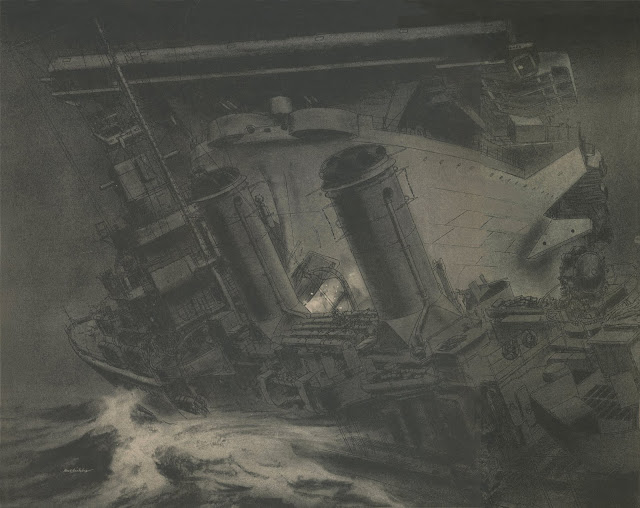...but he was first and foremost a draftsman. He used the most basic black and white tools to achieve the most extraordinary results. For example, working on a small scale with humble materials he was able to create the illusion of epic events:
The following is Sickles' drawing of one of the worst disasters in Naval history-- the night collision of the aircraft carrier USS Wasp with the USS Hobson. You'd think that such an immense topic would require a big canvas and a full range of colors. But look at what Sickles was able to accomplish with graphite on a small piece of illustration board:
Sickles gives us a sense of the scale by his extreme foreshortening of the Hobson and his depiction of the looming Wasp, lit from below by the sparks from the collision. The tilt of the lumbering Hobson gives us a sense for the immense weight of these ships.
A less skilled hand would dramatize the impact using bright fireballs and plumes of smoke. With a highly limited value scale, Sickles does a more potent job. (I've often quoted Thucydides: "Of all manifestations of power, restraint impresses men most.")
As always, Sickles' linework-- even in a night scene-- reassures us that he is firmly in control of the structure of his subject:
Delicate details such as this were important to show on the Hobson, so viewers would understand its vulnerability in the path of the huge, implacable Wasp.








5 comments:
Sickles at his best. Thanks!
David wrote
"reassures us that he is firmly in control of the structure of his subject:"
Which really means he understood the nature of space.
Gosh, yes, this seems like a completely different artist. I wasn't familiar with Sickles' paintings, so thank you for posting this David.
Confessing a bias but not without justification: the best comic strip artists (and Mr. Sickles was one of the best in his short career as such) were also, at least potentially (even if they decided not to pursue such a calling as Mr. Sickles did), among the greatest illustrators. Thank you for these entries Mr. Apatoff.
Kev Ferrara-- I like this one too, but for me Sickles' best will always be his sensitive linework-- his series on the civil war, his illustrations about the Vietnam war, and some of his series for Life Magazine.
Tom-- Yup.
chris bennett--I think many people don't know-- or have forgotten-- about the range and depth of Sickles' work. He was deeply respected for his draftsmanship by the best illustrators during his lifetime, but always fell just below that top tier. When Albert Dorne was trying to assemble the 12 most famous artists for the Famous Artists School, he considered inviting Sickles to handle drawing, but ultimately concluded that Austin Briggs could fill that slot. I'd probably make that same choice, but being 13th in a field of artists such as Rockwell, Fawcett, Briggs and von Schmidt is no sin. That's one reason I wanted to post more of his work here.
comicstripfan-- I agree. In fact, I think in the 1920s and 1930s some talented artists wanted to move from comic strips to illustration (for example, Austin Briggs, Alex Raymond) because illustration paid more and its future seemed brighter. But by the late 1950s and 60s, the talent (Leonard Starr, etc.) started moving in the other direction because photography was beginning to erode the field of illustration while cartooning remained profitable. And then of course, Hal Foster found a way to combine the two fields.
Post a Comment